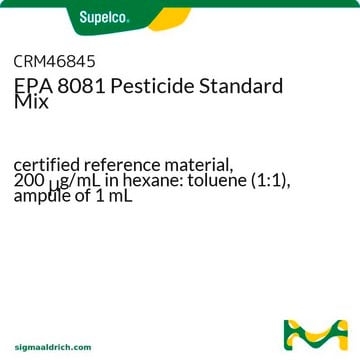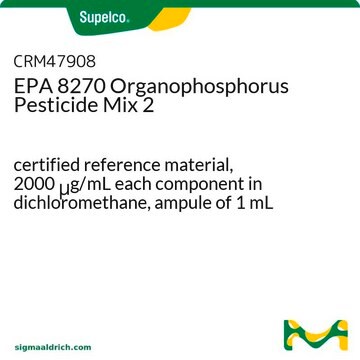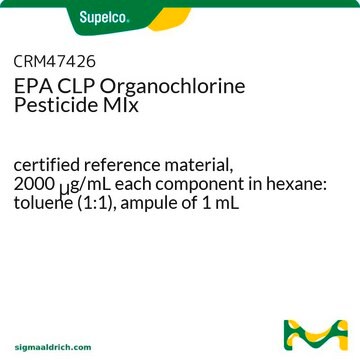55173-U
Supel™ QuE QuEChERS tube
PSA/C18 (EN) Cleanup Tube, pack of 100, suitable for EN 15662:2008 per BS
Synonym(s):
QuEChERS
Sign Into View Organizational & Contract Pricing
All Photos(1)
About This Item
UNSPSC Code:
41115712
NACRES:
NB.21
Recommended Products
product name
Supel™ QuE, PSA/C18 (EN) Cleanup Tube, pack of 100, suitable for EN 15662:2008 per BS
agency
suitable for BS EN 15662:2008
Quality Level
composition
Discovery® C18, 25 mg
magnesium sulfate, 150 mg
Supelclean™ PSA, 25 mg
packaging
pack of 100
technique(s)
QuEChERS: suitable
centrifuge tube volume
2 mL
application(s)
food and beverages
Looking for similar products? Visit Product Comparison Guide
Related Categories
General description
Dispersive SPE (dSPE), often referred to as the "QuEChERS" method (Quick, Easy, Cheap, Effective, Rugged, and Safe), is modern sample prep technique that is becoming increasingly popular in the area of multi-residue pesticide analysis in food and agricultural products.
Using the QuEChERS method, food/agricultural samples are first extracted with an aqueous miscible solvent (e.g., acetonitrile) in the presence of high amounts of salts (e.g., sodium chloride and magnesium sulfate) and/or buffering agents (e.g. citrate) to induce liquid phase separation and stabilize acid and base labile pesticides, respectively. Upon shaking and centrifugation, an aliquot of the organic phase is subjected to further cleanup using SPE. Unlike traditional methods using SPE tubes, in dispersive SPE, cleanup is facilitated by mixing bulk amounts of SPE (e.g., Supelclean PSA, ENVI-Carb, and/or Discovery DSC-18) with the extract. After sample cleanup, the mixture is centrifuged and the resulting supernatant can either be analyzed directly or can be subjected to minor further treatment before analysis.
Supelco carries a line of vials and centrifuge tubes containing pre-determined amounts of salts and SPE sorbents to support the most common method configurations used today.
Using the QuEChERS method, food/agricultural samples are first extracted with an aqueous miscible solvent (e.g., acetonitrile) in the presence of high amounts of salts (e.g., sodium chloride and magnesium sulfate) and/or buffering agents (e.g. citrate) to induce liquid phase separation and stabilize acid and base labile pesticides, respectively. Upon shaking and centrifugation, an aliquot of the organic phase is subjected to further cleanup using SPE. Unlike traditional methods using SPE tubes, in dispersive SPE, cleanup is facilitated by mixing bulk amounts of SPE (e.g., Supelclean PSA, ENVI-Carb, and/or Discovery DSC-18) with the extract. After sample cleanup, the mixture is centrifuged and the resulting supernatant can either be analyzed directly or can be subjected to minor further treatment before analysis.
Supelco carries a line of vials and centrifuge tubes containing pre-determined amounts of salts and SPE sorbents to support the most common method configurations used today.
Legal Information
Discovery is a registered trademark of Merck KGaA, Darmstadt, Germany
Supel is a trademark of Sigma-Aldrich Co. LLC
Supelclean is a trademark of Sigma-Aldrich Co. LLC
Storage Class
13 - Non Combustible Solids
wgk_germany
WGK 3
flash_point_f
Not applicable
flash_point_c
Not applicable
Choose from one of the most recent versions:
Already Own This Product?
Find documentation for the products that you have recently purchased in the Document Library.
Customers Also Viewed
Maria Teresa Salles Trevisan et al.
Journal of chromatography. A, 1512, 98-106 (2017-07-20)
An analytical method using a quick, easy, cheap, effective, rugged and safe (QuEChERS) procedure for multi-residue determination of 52 pesticides in coffee leaf extractshas been developed and validated according to SANTE/11945/2015 guidelines. Different sorbent combinations for dispersive solid phase extraction
David Moreno-González et al.
Talanta, 128, 299-304 (2014-07-26)
In this study a fast, selective and sensitive multiresidue method based on QuEChERS methodology has been evaluated and validated for the determination of carbamate pesticides, in edible vegetable oils by UHPLC-MS/MS. A new clean-up sorbent, Supel(TM) QuE Z-Sep(+), has been
Lijun Han et al.
Journal of separation science, 39(23), 4592-4602 (2016-11-03)
A novel carbon/zirconia-based material, Supel
Our team of scientists has experience in all areas of research including Life Science, Material Science, Chemical Synthesis, Chromatography, Analytical and many others.
Contact Technical Service






